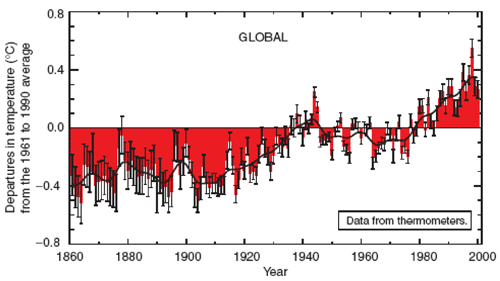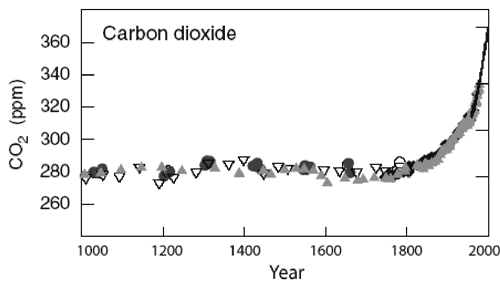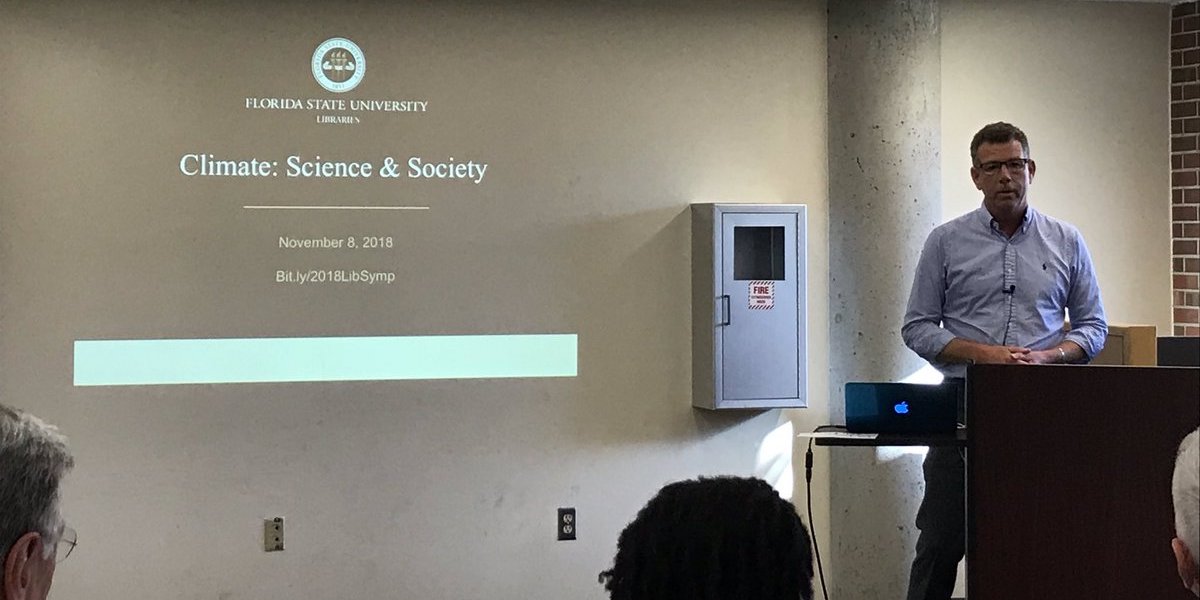Climate Change Basics for the Southeast USA (from AgroClimate)
"Warming of the climate system is unequivocal, as is now evident from observations of increases in global average air and ocean temperatures, widespread melting of snow and ice, and rising global average sea level.
-Fourth Assessment of the Intergovernmental Panel on Climate Change (IPCC)
Climate Change versus Global Warming
“Climate change” refers to the variation in the Earth's global or regional climates over time. It describes changes in the atmosphere over time scales ranging from weeks to decades to millions of years. These changes can be caused by natural processes internal to the Earth, such as continental drift, which affects ocean currents, external forces, such as variations in sunlight intensity, or human activities. “Global warming” has come to refer to an increase in average global temperatures as influenced by increased greenhouse gas concentrations without regard to other factors that may cause climate to change
Natural, long-term changes occur in response to fluctuations in the amount of solar energy reaching the Earth, changing ocean currents, formation or loss of ice sheets, and many other causes. Global climates also vary naturally in response to shorter-term events, such as volcanoes, which send sun-blocking particles into the stratosphere to cool the Earth, or the Pacific Ocean event known as El Niño, which affects global wind patterns, rainfall, temperatures, and other climate features thousands of miles away.
In addition to these natural causes of climate variability, human activities influence climate in many ways. Land use changes, such as irrigation of historically semi-arid areas for farmland, paving and development of sprawling urban areas, draining of wetlands, and emissions of greenhouse gases or aerosols into the atmosphere are all human activities that can affect the Earth’s climate system. Perhaps the most significant human influence today is the increasing levels of greenhouse gases in the atmosphere, including carbon dioxide (CO2), methane (CH4), and nitrous oxides (NOx), which contribute to a general warming of our planet (Figure 1).

Figure 1. Global temperature shifts over the past 140 years. The zero line represents the 30-year average temperature from 1961 to 1990, which the World Meteorological Organization has designated to be the base for climatology. Source: Fourth Assessment of the Intergovernmental Panel on Climate Change (IPCC).
The Science of Greenhouse Gases and Climate Change
Much of the CO2 that we release to the atmosphere is a by-product of energy use, whether through burning fuels for transportation, generation of electricity, or other purposes. Burning fossil fuels releases carbon dioxide into the atmosphere, increasing atmospheric carbon and altering the pre-existing balance of greenhouse gases.
Greenhouse gases, including CO2, have the property of allowing the atmosphere to retain more heat energy as their concentration in the atmosphere increases. Water vapor is the Earth’s most important greenhouse gas. Water vapor and clouds cause most of the Earth’s greenhouse effect, accounting for about 90% of the total heat-retaining capacity of the atmosphere. Two bases for the conclusion that human activity has contributed to recent trends in climate change are: 1) observations that atmospheric CO2 concentrations have increased from about 280 parts per million (ppm) to nearly 400 ppm over past 150 years while global average temperatures have warmed about 1.25° degrees Fahrenheit (°F), though the temperature vs. CO2 correlation is not perfect, and 2) scientific theories of atmospheric physics and heat transfer. This rise in global average temperature has tracked increases in CO2 emissions from burning fossil fuels, deforestation, and other sources, which supports the hypothesis formulated by physical scientist Guy Stewart Callendar in 1930 that CO2 emissions could enhance the greenhouse effect.

Figure 2. Atmospheric CO2 concentrations as measured from ice cores and direct measurements. Source: Fourth Assessment of the Intergovernmental Panel on Climate Change (IPCC).
Historical Climate Trends in the Southeast USA
“Global warming” refers to the average temperature of the entire Earth's atmosphere. However, much regional and seasonal variation occurs within that global average. Most of the recent warming has been measured in the northern hemisphere, particularly over northern Canada and Siberia, with less warming in the tropics and subtropics.
Climate data from three states, Alabama, Georgia, and Florida, show that annual average temperatures fluctuate widely from year to year (Figure 3). Relatively warm periods occurred in the 1930’s, 1950’s, and the past decade, whereas the 1970’s were relatively cool.

Figure 3. Annual average temperatures for Alabama, Florida, and Georgia from 1895 through 2006. Source: National Climate Data Center, NOAA.
In all long-term temperature records, factors such as instrument changes, station moves, changes in observation times, and changes in exposure can introduce artificial jumps or trends into the data records. Because of heat island effects, weather stations that are located near cities show warmer temperatures than nearby rural areas. Analyses of long-term records in Florida indicate that most rural weather stations have experienced a cooling trend in average temperatures while those near urban areas have had a warming trend. Large areas of Alabama and Georgia that were used for row crop agriculture (corn and cotton) have been planted to forests, which may have led to a net cooling of the local environment. Most global or even regional temperature analyses (like Figure 3) can not account for these site-specific factors.
Rainfall is among the most important climate variables for agriculture and water resource management. Since 1895, annual total rainfall in the three Southeast states shows great year-to-year variability, with rainfall increasing about 10% for all three states during the past century (Figure 4). State and regional averages of annual total rainfall mask a great deal of the variation among and even within counties and variability in timing of rainfall within each year. Southeast rainfall totals are strongly influenced by tropical storms. One notable change over the past century is an increased frequency of rainfall events of two inches or more. While these storms increase the total annual rainfall, they are less useful to agriculture than smaller rainfall events distributed evenly during the growing season.

Figure 4. Annual total rainfall averaged for Alabama, Florida, and Georgia from 1895 through 2006. Source: National Climate Data Center, NOAA.
Climate Change and Hurricanes
Of particular importance to the Southeast is the possible change in hurricane frequency or intensity. The science is currently conflicted, with some studies showing an increase in Atlantic hurricane frequency and intensity and others showing that storm frequency follows a 30- to 50-year cycle associated with changes in ocean currents. Recent claims that hurricane frequency has increased may merely reflect better detection of storms in the post-satellite era. Figure 5 shows annual numbers of Atlantic basin hurricanes and tropical storms since 1855. Several periods of increased activity can be seen in the late 1800’s, the 1930’s, the 1950’s, and from 1995-2005. Relatively inactive periods occurred around 1920, 1970, and 1985. There is a general trend of increasing activity over the whole period, but whether that is real or just an artifact of poor detection of storms before aircraft reconnaissance or satellites is a subject of intense debate.

Figure 5. Numbers of hurricanes and tropical storms for the Atlantic Basin from 1850 to 2005. Source: National Climate Data Center, NOAA.
Prediction of hurricane frequency and intensity is very uncertain, in part, because the computer models that simulate future climate are not able to resolve individual storms. The simple theory is that a warming planet will lead to warmer sea surface temperatures, which fuel hurricanes, thereby causing more and stronger storms. Other studies show that warming will lead to more El Niño events, which hinder hurricane development. Climatologists are working hard to resolve these discrepancies, but there is too much uncertainty now to predict how climate change will affect hurricanes.
What are the climate projections for the Southeast USA?
Forecasting weather and climate is not an exact science. Projections of climate change are based on climate models, which are complex computer programs that attempt to describe how the atmosphere will behave through time in response to the forces that act upon it. The computer models try to mimic how climate variables might respond to greenhouse gases and other projected results of human activities over the next 100 years. According to the 2007 report of the Intergovernmental Panel on Climate Change (IPCC), these models indicate that global average surface temperatures may rise from 3°F to 7°F by the year 2099.
History has shown that global increases in temperature are not evenly distributed. For this reason, one cannot simply add 3°F to 7°F to existing temperatures in the Southeast for an idea of future climate. More importantly, a changing climate will likely not affect just the average temperature, but also the occurrence of extreme events and the variability of temperature over time and space. So far, we do not yet know whether droughts, floods, heat waves, freezes, or storms will become more or less frequent.
Another impact of climate change is on the height of the sea level. As average global ocean temperatures increase, ocean water expands and sea levels rise. The Intergovernmental Panel on Climate Change estimates that sea level will to rise from 8 to 23 inches by 2099. In the Southeast, sea level has risen steadily over the last 100 years at a rate of 8.5 inches per century with no apparent acceleration.
For more information about how climate change is expected to impact the Southeast U.S., view the latest National Climate Assessment, released in 2018. To summarize, the climate of the Southeast is likely to change in the next decades. While the extent of these changes is subject of intense debate, we need to prepare for the challenges posed by climate change by becoming a more efficient society, reducing greenhouse gas emissions, identifying vulnerable sectors of society, and developing adaptation strategies.





